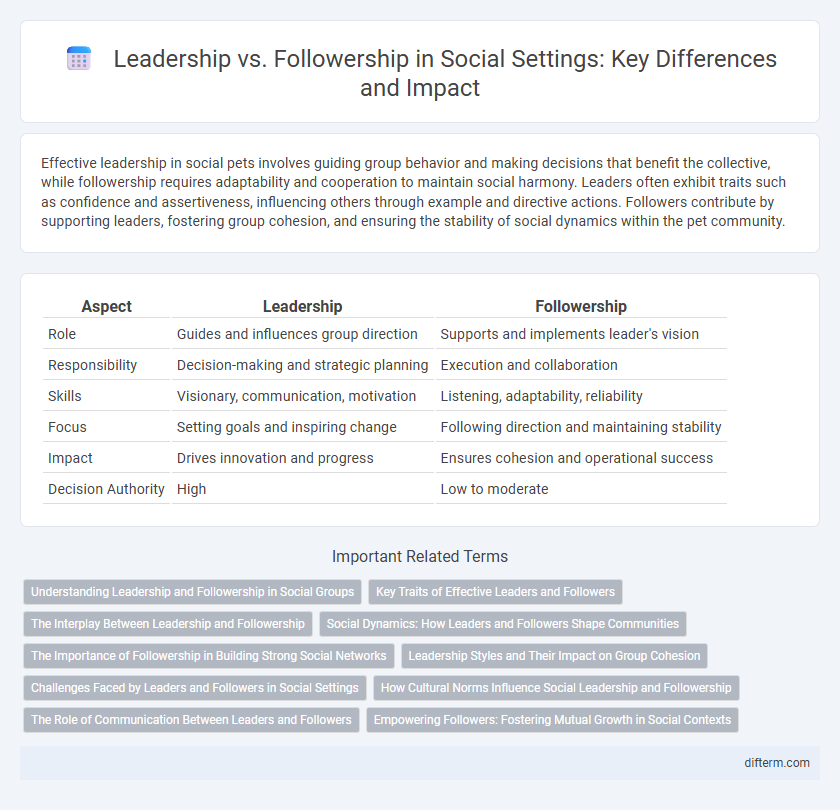Effective leadership in social pets involves guiding group behavior and making decisions that benefit the collective, while followership requires adaptability and cooperation to maintain social harmony. Leaders often exhibit traits such as confidence and assertiveness, influencing others through example and directive actions. Followers contribute by supporting leaders, fostering group cohesion, and ensuring the stability of social dynamics within the pet community.
Table of Comparison
| Aspect | Leadership | Followership |
|---|---|---|
| Role | Guides and influences group direction | Supports and implements leader's vision |
| Responsibility | Decision-making and strategic planning | Execution and collaboration |
| Skills | Visionary, communication, motivation | Listening, adaptability, reliability |
| Focus | Setting goals and inspiring change | Following direction and maintaining stability |
| Impact | Drives innovation and progress | Ensures cohesion and operational success |
| Decision Authority | High | Low to moderate |
Understanding Leadership and Followership in Social Groups
Leadership in social groups shapes collective goals and motivates members through vision and influence, while followership involves active engagement and support that sustains group cohesion and effectiveness. Effective social dynamics require a balance where followers contribute critical feedback and adaptability, enabling leaders to adjust strategies and enhance group success. Understanding the interdependence of leadership and followership reveals how power, communication, and shared values drive social group development and resilience.
Key Traits of Effective Leaders and Followers
Effective leaders demonstrate visionary thinking, emotional intelligence, and decisive communication, enabling them to inspire teams and drive innovation. Followers exhibit adaptability, reliability, and proactive engagement, supporting leaders while contributing valuable feedback and diverse perspectives. The synergy between leadership and followership fosters organizational success through mutual trust and collaborative achievement.
The Interplay Between Leadership and Followership
Effective leadership and followership are interdependent, shaping organizational success together through dynamic interaction and mutual influence. Leadership provides vision and direction, while followership offers support, feedback, and engagement, creating a balanced system of collaborative achievement. Understanding this interplay enhances team performance, fosters trust, and drives continuous innovation within social and professional environments.
Social Dynamics: How Leaders and Followers Shape Communities
Leaders influence social dynamics by setting visions that inspire collective action and foster community cohesion. Followers contribute through active engagement and support, reinforcing shared values and sustaining group momentum. The interplay between leadership's direction and followership's cooperation shapes resilient, adaptive communities.
The Importance of Followership in Building Strong Social Networks
Effective followership plays a crucial role in developing strong social networks by fostering trust, collaboration, and mutual support among group members. Followers who actively engage and contribute to shared goals enhance communication flow and create a resilient community dynamic. Recognizing the value of followership encourages balanced relationships where leaders and followers work synergistically to achieve collective success.
Leadership Styles and Their Impact on Group Cohesion
Leadership styles, including transformational, transactional, and laissez-faire, significantly influence group cohesion by shaping communication patterns and trust levels within teams. Transformational leadership fosters higher group cohesion through inspiration and motivation, enhancing collaboration and commitment among members. In contrast, transactional and laissez-faire styles may result in weaker cohesion due to their focus on contingent rewards or lack of active guidance.
Challenges Faced by Leaders and Followers in Social Settings
Leaders in social settings often confront challenges such as managing diverse group dynamics, addressing conflicting interests, and maintaining credibility and trust among followers. Followers face obstacles like aligning with leadership vision, balancing autonomy with compliance, and navigating group pressures. Both roles require emotional intelligence and effective communication to foster mutual understanding and collaboration.
How Cultural Norms Influence Social Leadership and Followership
Cultural norms shape social leadership and followership by defining acceptable behaviors, communication styles, and power dynamics within groups. In collectivist societies, leadership often emphasizes group harmony and consensus, encouraging followership based on shared values and relational trust. Contrastingly, individualistic cultures prioritize assertive leadership and autonomous followership, reflecting a more hierarchical and performance-driven social structure.
The Role of Communication Between Leaders and Followers
Effective communication between leaders and followers establishes trust, clarity, and mutual understanding, which are essential for achieving organizational goals. Leaders must convey vision and expectations clearly, while followers provide feedback and insights that shape decision-making processes. Strong dialogue fosters collaboration and adaptability, enhancing overall group performance and engagement.
Empowering Followers: Fostering Mutual Growth in Social Contexts
Empowering followers creates a dynamic where leadership and followership drive mutual growth through trust, open communication, and shared goals. Effective leaders cultivate followers' skills and autonomy, enhancing collective problem-solving and innovation in social settings. This reciprocal empowerment strengthens community bonds and promotes resilient, adaptive social groups.
leadership vs followership Infographic

 difterm.com
difterm.com